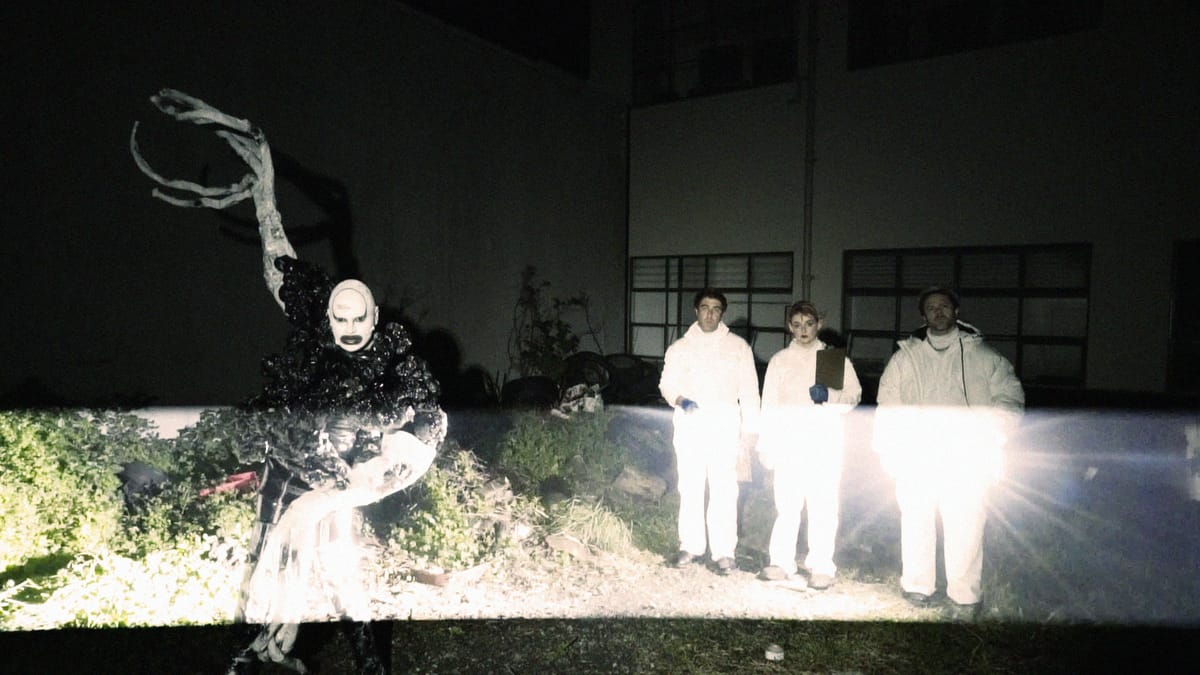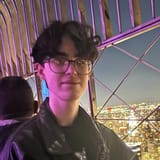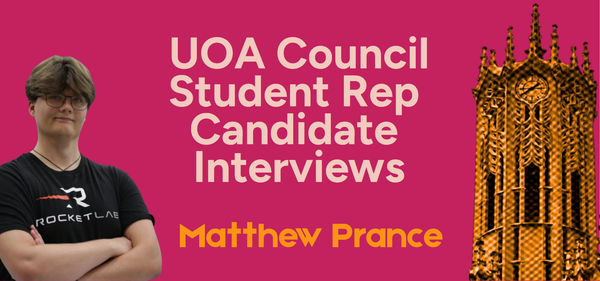Glory Whole: Behind the Viewing Hole with Grecco Romank and Copper MaeSteal
Craccum sat down with Grecco Romank members Bille Fee and Damian Golfinopoulos and drag creature Copper MaeSteal to discuss their upcoming collaboration ‘Glory Whole.’

As part of the Festival for Live Art ('FOLA'), "decayed opulence" band Grecco Romank and "drag creature" Copper MaeSteal are collaborating on a new project Glory Whole: a multisensory performance that explores themes of perfection and relationship through the contradictions of horror and glamour. Craccum sat down for an interview to discuss these themes and the process of putting this collaboration together.
Both Grecco Romank and Copper MaeSteal are very genre-defying projects, and there are a lot of ways to potentially describe your art. What are some of your favourites?
Copper MaeSteal: I would describe myself as a ‘drag creature.’ I love to play with the bizarre and the disturbing as well as playing with the glamorous. I love the contradictory elements and being able to play with that in people’s perspectives – so people can see something glamorous and bizarre at the same place, or something grungy in a glamorous place.
Billie Fee: Similarly, for Grecco, we also play a lot with contradictions. We love the bizarre and grotty and making music that sounds ‘harsh’, but we do also play with camp-ness and opulence. We sometimes describe ourselves as being ‘decayed opulence.’
Damian Golfinopoulos: A ’90s euro-dance act, seen in a funhouse mirror, covered in toxic waste.
Billie Fee: There we go. Oh, yeah, by the way, we’re a band.
How did you begin to collaborate?
Billie Fee: I met Copper at AUT. We were both studying design, and I remember liking Copper’s outfits and being like…
Copper MaeSteal: Vice versa. I remember seeing Billie at uni wearing these crazy-ass outfits, and I was like, she is the one!
Billie Fee: Then I found out that he did drag and started cyber-stalking him a little bit, forcing my way into group projects and stuff.
Damian Golfinopoulos: Billie showed me Copper’s creations and I was floored. I don’t see a lot of folk doing that kind of prosthetic and costume work. It brought in elements of Cronenbergian horror that are things crawling around in Grecco’s imagination anyway. So, it was a no-brainer to ask to work with Copper, which we did on our music video Human Bin, which was a lot of fun.
Tell me about Glory Whole. I’d love to hear about some of the creative decisions – in particular, I am very intrigued by the role of the audience.
Copper MaeSteal: Grecco Romank had this event in the work with FOLA, and they got me to come over one day to concept some upcoming creative plans. We had a couple of times of hanging out and going through some concepts and seeing what we could do as it was very much a blank canvas to work with at the start – what story and what narrative and what music we wanted to produce and tell.
At the start, some of the keywords that came up were playing on ‘perfectionism’ as well as human connection for one another, as well as this disturbingly bizarre aesthetic and environment. We touched on Glory Whole as a concepting idea as we knew it wouldn’t be a typical stage performance - the audience would have a different perspective than what they normally would. We were thinking about people viewing through a hole all the ways people interact with one another.
Damian Golfinopoulos: You’re asked to look through the hole and you’re not sure what is gonna poke you in the eye or come out on the other side. It is intriguing for us to put the audience in a situation where there are something like six points of interest. It’s a multimedia, multisensory, squirming performance happening on multiple stages around you. It’s been a long time coming for us to take the Grecco experience, which is often limited by being (as much as we love it) in a band format, and working with a visual and creative artist like Copper, bringing that together, and confusing the audience.
Copper MaeSteal: The narrative storyline is touching on human connection and the need for validation from each other as well as ourselves in our lives. We are keeping that through our storyline through this glory hole and touching this workout aesthetic, surgery, and this image of oneself and how people view themselves. That relates to the audience in an interesting way of how the audience mingles around and is almost in the middle of the performance. There is a back-and-forth of they’re watching us perform and we’re watching them perform with their reactions.
Can you tell me about the horror in this performance?
Billie Fee: From the Grecco perspective, horror, and in particular body horror, is always a big influence for us and our lyrics and our aesthetic. I think that, going back to the idea of contradictions, that is also a point of intersection between us and Copper’s aesthetic: this kind of fleshiness. The fact that we’re all sort of trapped in these bodies and there’s no way to live outside of them. That has beauty with it, but it also has horror. It’s a constant grappling with one’s own body.
Damian Golfinopoulos: But, when you see conflict come to a head, when there is a final cataclysm, that brings catharsis. That is why horror is a beacon in the voice of what Grecco tends to focus on. But, with that dark, is also humour – two things can happen at the same time. There is no need for it to be perceived as having a specific tone.
Copper MaeSteal: I think we also bring in those contradictions as we mentioned before with this glamour-horror back-and-forth. Though we have these elements of body horror, and these bizarre, horrific moments, they’re still compensated with Billie singing these extremely glamorous high notes, and these other glamorous performances and outfits. So, though it will be very horrific and disturbing, it will also be very comical. It really depends on how much the audience wants to take away from it. If an audience member wants to just enjoy it as a live performance and leave, that’s fine. But if they want to go in questioning their world, their skin, and their beliefs, it helps with that narrative as well.
Damian Golfinopoulos: I think that a thing that doesn’t always come through is that fun is really important. There is this sense for things to be dumb but fun. Things are not fun around us, so let’s give it back.
Grecco Romank and Copper MaeSteal previously collaborated on the music video Human Bin.
This performance involves both a music group and a drag creature at the same time. What roles will the two projects play together in the piece?
Copper MaeSteal: We’ve got Damian on the control board doing all the electronics and the musical story and timing. I am there almost as the physical embodiment of him, carrying through the storyline of the music. I’m there to persuade Billie and Mikey – the singers – to strive for this bizarre level of perfectionism. At the start, Billie and Mikey start out very confused, but they take to me as a calming being, which fits into the contradictory element as I am going to appear very bizarre.
So, it’s very much Grecco heavily on the music and Copper heavily on the performance, and then we mix and intersect where my performance is derived and driven by the music, and Billy and Mikey, their performance is based off of my reactions to them and the world I forced them into.
What are some things your audiences may recognise or view as different about this piece?
Billie Fee: People will recognise all our music, but the arrangement of the theatre is different to how we normally perform in venues. And, obviously, with Copper there, creating a different dynamic between the four of us and the audience.
Copper MaeSteal: The similarities for me will be in the aesthetics, the visual design, and the kinds of emotions attached to that. However, the materials and some of the prop design I haven’t done before – it’s solely new for this.
Also, coming from a drag background, doing smaller performance numbers, this being an hour-long performance piece is something quite different for me and for people who have seen me or my work in the past. It’s going to be a very interactive, very elongated art piece, and it's based on Grecco’s music, which is also something I haven’t performed before.
What has it been like being part of FOLA? Are there any other creators or pieces you are excited about?
Damian Golfinopoulos: I’m really excited to see Samuel Te Kani’s piece. Sam has contributed a wonderful essay to the book Grecco has put out for its third album, Arts Colony, available at the Grecco Romank BandCamp.
It’s been amazing to work with everyone [from FOLA], from the marketing team through to the technical side. The team have supported us and not constricted us in any way. If someone needed to be waterboarded, they were there. If we needed to bring in a smashed-up Corolla, they would have tried to find a way to help us bring that in. It is really great fun to be involved in this festival and to have so many interesting artists brought together.
Billie Fee: It’s a totally unique offering for the city, I think. Like this piece, a lot of the other pieces are quite genre-defying. It’s not quite theatre, it’s not quite performance art, it’s not quite a music gig – it's sort of a combination of all of those things. So, for those things that don’t fit into traditional categories, it’s a very special festival.
Copper MaeSteal: I’m extremely grateful for being able to be a part [of FOLA] with Grecco - being able to be given this blank canvas, them saying “what do you want to do?” and having all these people here to support it and live for your work and really want to see it come to life and see you be passionate and secure. I’m excited to see Moe Laga, they’re doing Fetū x Fetu’u before us.
Do you have any advice for young creatives who read Craccum?
Billie Fee: I would say meet people. I was very lucky to have met Copper at uni. Talk to other people, try and find those people that have similar worldviews or aesthetics or tastes, or that you can collaborate with. Also, take advantage of the facilities – you get so much access to machines and resources. That includes the knowledge of the lecturers and technicians. I wish I had done more using the machines that are now really expensive to access.
Damian Golfinopoulos: Don’t ever let budgets constrain you from projects. Always learn to make things with limited means, and use that as a test of whether you enjoy doing the thing or not. Never allow it to not be fun. If it starts to get not fun, you need to stop and question whether it’s worth doing and if you can eliminate those aspects. Nobody’s going to save you, you have to enjoy making creative stuff for the passion of it.
Bille Fee: Assume you’re gonna make no money.
Copper MaeSteal: Just going for it as much as you can, and really not caring about other people’s validation or need to push you. While we do have a lot of community, we do rely on ourselves at the end of the day to get out of bed and create art and our own purposes. That goes off of what we were saying about finding community and those people you bounce off of and can create amazing work with, because when you do that, I think you really find your purpose in life.
Finally, where can people find out more about you guys and about Glory Whole?
Billie Fee: You can follow us @greccoromank. All of the information about us and the show is all there.
Copper MaeSteal: There’s also my Instagram, @coppermaesteal. There’s all the info there for the event, and any upcoming projects or work will also be posted there.
Damian Golfinopoulos: Of course, you’ve gotta go to the FOLA website in order to not only find out more about us but also check out the rest of the programme.
Glory Whole is being performed at the Basement Theatre on Saturday, 14th June, as part of the Festival of Live Art (FOLA). Tickets can be purchased at https://www.iticket.co.nz/events/2025/jun/fola-glory-whole





